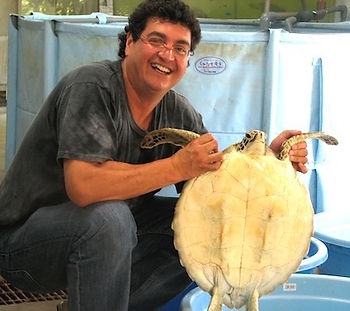ZooPlankton
ZooPlankton is one of the most vital organisms for thriving life under the sea. They spend their days at the bottom of the body of water they are residing in, hiding here to escape predators that can easily detect them during the day.
However, when the sun goes down they retreat from the security of the dark and head to the surface through a migration known as "diel vertical migration". This migration is dictated by the change in light levels, which is at risk due to growing light pollution.
With higher intensity light levels during prime migration times for Zooplankton there is an extreme risk in altering their migration. By preventing Zooplankton the safety to travel to the surface and exchange nutrients there is risk of excessive algae production which would have adverse effects on water quality.
In addition, there is a high potiential of disrupting the the productivitiy and cycling of carbon and nutrients that are vital elsewhere in the ecosystem, thereforechanging food chain wide migration patterns.

Light Pollution & Marine Species
Coral Reefs
Home to more than 4,000 species of fish alone plus thousands of different marine organisms, coral reefs serve as vital structures for protecting and housing marine life.
Although coral reefs have the most substanial benefits below the surface, they have also proven to be vital to life on land. Not only do they provide tourism to coastal communities, but they can also be used to protect shorelines from oceanic damages.
However, through a process called Satellite Based Observation of Nocturnal Lighting and Coral Reef Monitoring, Coral Reefs are being severly damaged. Developed by the National Oceanic and Atomospheric Administration, scientists are using a "Light Proximity Index" system to evaluate the stressors that are put on coral reef systems. Unfortunately, the light used to detect these stressors can have an effect on the biological clocks of the photosensitive species within the reef system, preventing the reef from thriving off of the species that it houses and allows predators to have a significant hunting advantage.

Sea Turtles
Sea Turtles are a staple species in marine conservation and are severly endangered all over the globe.
While light pollution is one of the lesser known issues associated with sea turtles, the outcomes of light pollution can prove detrimental to their already dwindling numbers.
One risk associated with light pollution is the fact that it deters females from nesting on the beach. In an effort to avoid the light, the females will choose less appropriate nesting sites which creates risks for the hatchlings or they could lay their eggs at sea, which would produce no off spring at all.
Another light pollution based problem is that once the hatchlings are born, they head in the brightest direction, which used to be the moon guiding them to the ocean. Light caused by industrialization is causing the hatchlings to orient towards the closest human community instead. This can result in dehydration and eventually death for the hatchlings.
Interview with Professor Alonso Aguirre
Alonso Aguirre is an an Associate Professor with the department of Environmental Science and Policy at George Mason University in Fairfax, Virginia. His research includes wildlife disease ecology, conservation medicine and ecohealth. Growing up in the coastal community of Baja California, Mexico, an area rich in sea turtles, Professor Aguirre's conservation research with sea turtles been going on for more than a decade.

